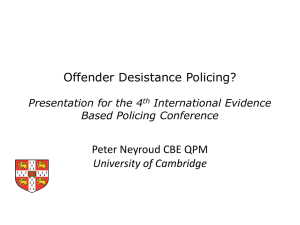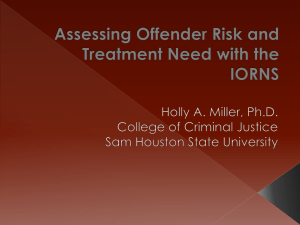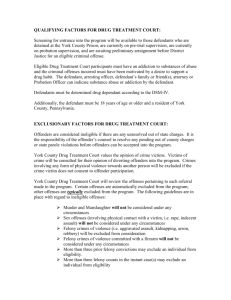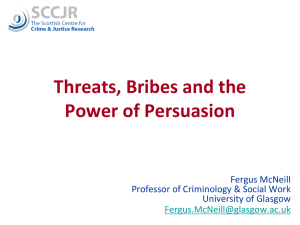Desistance and “Aging-out” of Offending after
advertisement
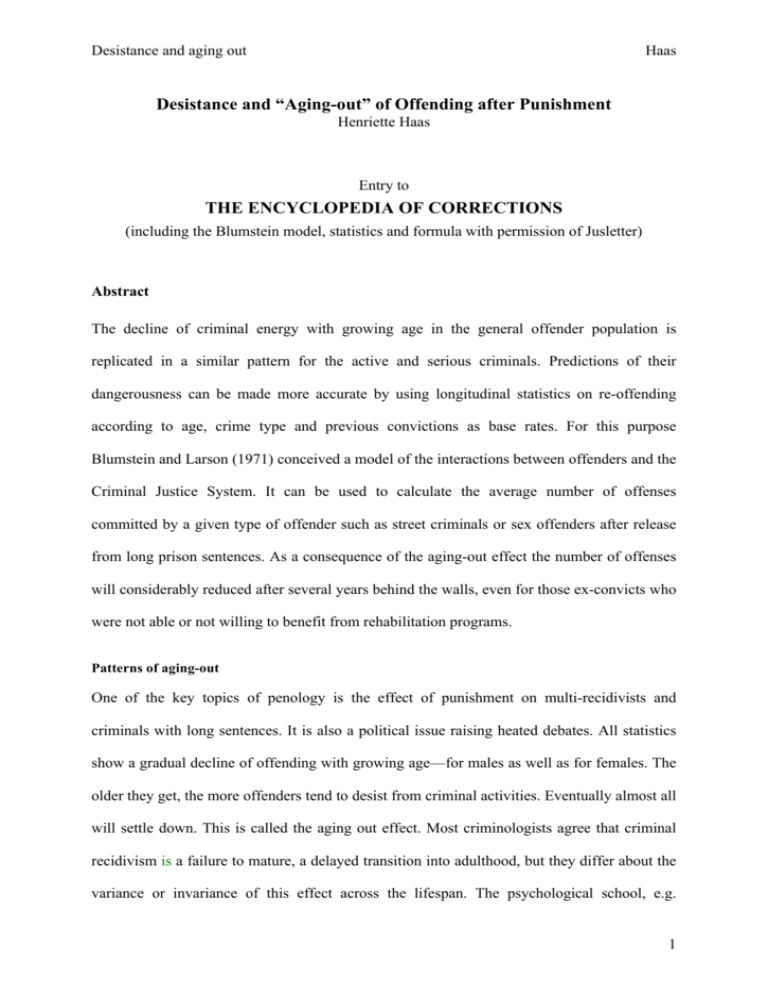
Desistance and aging out Haas Desistance and “Aging-out” of Offending after Punishment Henriette Haas Entry to THE ENCYCLOPEDIA OF CORRECTIONS (including the Blumstein model, statistics and formula with permission of Jusletter) Abstract The decline of criminal energy with growing age in the general offender population is replicated in a similar pattern for the active and serious criminals. Predictions of their dangerousness can be made more accurate by using longitudinal statistics on re-offending according to age, crime type and previous convictions as base rates. For this purpose Blumstein and Larson (1971) conceived a model of the interactions between offenders and the Criminal Justice System. It can be used to calculate the average number of offenses committed by a given type of offender such as street criminals or sex offenders after release from long prison sentences. As a consequence of the aging-out effect the number of offenses will considerably reduced after several years behind the walls, even for those ex-convicts who were not able or not willing to benefit from rehabilitation programs. Patterns of aging-out One of the key topics of penology is the effect of punishment on multi-recidivists and criminals with long sentences. It is also a political issue raising heated debates. All statistics show a gradual decline of offending with growing age—for males as well as for females. The older they get, the more offenders tend to desist from criminal activities. Eventually almost all will settle down. This is called the aging out effect. Most criminologists agree that criminal recidivism is a failure to mature, a delayed transition into adulthood, but they differ about the variance or invariance of this effect across the lifespan. The psychological school, e.g. 1 Desistance and aging out Haas represented by Moffitt (1993, 1994), claims the existence of two types of antisocial trajectories: adolescence-limited offenders (ALO) and persistent offenders (PO). The latters’ antisocial behavior goes back to their childhood and their crimes tend to be more frequent and more serious than the formers. POs also show more psychopathology than ALOs, whereas the ALOs resemble much more the non-delinquent population (abstainers)—in every respect. This concept falls in tune with the results of cross-sectional studies, beginning with Wolfgang, Figlio and Sellin’s (l972) who showed that a small number of persisters do enormous damage as they account for the biggest share of offenses and especially for almost all of the severe violent crimes committed by the members of a birth cohort. Moffit (2002) also showed with prospective longitudinal data that boys with severe childhood antisocial symptoms practically never recover. Even cases which seemed to have disappeared from the official records for a certain time span, unfortunately re-surfaced in the Justice system later. The sociological school, represented e.g. by Hirschi and Gottfredson (1983), claims the invariance of aging-out: they see gradual desistance in all offenders. Statistical evidence for the aging out process shown as curves of recidivism depending on age as well as on the number of previous convictions is difficult to find, but we did find data from Denmark (Figure 1) and one from the UK (Figure 4). These show a distinct, but slower decline in recidivism for the more active offenders compared to the rest. Figure 1 manifests the offense cluster committed by PO with more than 5 convictions. Thus the data mitigate theoretical controversies. 2 Desistance and aging out Haas Figure 1. Number of re-convictions of males according to age and previous convictions (StatBank Denmark, last visited on Jan. 20th 2014) Longitudinal studies on complete biographies of (former) offenders now shed a new light on the criminal career debate (Sampson & Laub 2003). These authors have collected the followup data on the Glueck sample of 480 delinquent boys. They found a universal pattern of desistance, varying for different types of crimes committed by the same group. Property crime peaks sharply during adolescence, becoming quite insignificant after age 25. For violent crime there is a rather flat inverted U-curve, beginning shortly before the twenties and lasting into the mid-thirties for the men. The curve of violence is overlaid by a much higher and wider inverted U-shape concerning alcohol and drug related crime, lasting from the early twenties until the beginning of the fifties for the men. One fourth of the men who survived to age 50 seemed to have stopped crimes of violence and property after age 17 (no arrests), half of them after age 25, and 80% had no arrests for predatory crime after age 40. Their data suggest that 3 Desistance and aging out Haas the age-crime decline in the general population is replicated—almost in the same fractal fashion—for the active serious offenders. Finally there is the very problematic group of the most severe criminals, such as leading organized crime figures and persistent sexual and violent predators. Even though they represent only a tiny fraction of the population, they attract the most media attention. For central Europe (FSO 1997) the prevalence of truly dangerous violent and sex offenders is about 1 out of 10,000 inhabitants (judged by the severity of prison sentences). Even if in more crime-ridden countries this figure could be doubled, no prospective study can ever contain a sufficient number of those rare cases so as to evaluate their offending pattern, not even those composed of juvenile delinquents. Considering the length of their sentences and the impossibility to release them when they are in their late thirties without risking victims and major scandals, they gradually build up the stock of inmates in maximum-security correctional facilities all over the world. Finding appropriate aging-out limits for them depends very much on the collection of longitudinal data such as shown in Figures 1 and 4 as base rates, which allow the application of Bayes’ theorem in the actuarial prediction of dangerousness (Wollert 2006). In conclusion both psychological and sociological schools have a point: Desistance is universal, however there seem to be personality-related clusters according to the severity of the antisocial behavior. A growing body of neurological studies (e.g. Raine, Moffitt, Caspi, Loeber, Stouthamer-Loeber & Lynam 2005) provides insights into probable causes for the occurrence of clusters. Adolescence-limited offending seems to be heavily mediated by the teenage brain’s reorganization under the hormonal surge, whereas persistent offenders suffer from frontal-executive dysfunctions since childhood, causing psychiatric symptoms of ADHD, addictions or personality disorders. This being said, social and psychological 4 Desistance and aging out Haas influences do also play a role, they can create, reinforce or contain neurological deficits. Cluster patterns stem from the neuronal network’s capacity to compensate deficits to a certain degree. With an accumulation of too many risks and when the load becomes too heavy, it organizes itself in a different manner. Then again this explanation remains incomplete as long as base rates of similar neurological deficits in the general population and the counterfactual are unknown, i.e. if there are any such neurologically affected individuals without antisocial tendencies. Considering aging-out after punishment It is widely recognized that non-custodial and custodial sanctions are quite effective for two thirds of all first-time offenders. Controversies about the efficiency of punishment focus most on the question of how to deal with multi-recidivists and with severe felons. The high recidivism rate of former prisoners is one frequently heard argument for a supposed inefficiency of incarceration (with finite sentences). There is also an implicit belief that deterrence by sanctions must totally prevent any new offense or else it would not be working at all. This fallacy originates from the confusion between re-conviction rates of individuals (in Figure 4) and the actual number of offenses committed (in Figure 1) or prevented. It also results from not considering the aging-out effect on recidivism in the later stages of a criminal career. Thus the real issue for public security is not the percentage of re-convictions, but the number of committed offenses and the increase or decrease in their severity of. The very existence of Criminal Justice puts a constant pressure on offenders—forcing them to be much more cautious than they would be otherwise. This greatly reduces their opportunities to commit crimes. Unfortunately the number of prevented offenses is difficult to estimate while re-arrest and reconviction figures are easily available. Blumstein and Larson (1971) created a Markov 5 Desistance and aging out Haas chain (Figure 2), modeling the interactions between offenders and Criminal Justice. The number of offenses (the expectation E) is a function depending on the offender’s proneness to crime and on the possibilities to thwart crime by prosecution. The model consists of four states: state 1 (transient) = active offending state 2 (transient) = apprehension by the police state 3 (transient) = conviction by the court state 4 (absorbing) = desistance from further offending. It also contains conditional probabilities (o = offending, a = apprehended, c = convicted): pa = p(a|o) the probability that an offender be (apprehended) arrested by the police after an offense pc = p(c|a) the probability that a police suspect be convicted after being apprehended for the offense p1 = p(o|o) an offender’s proneness to re-offend under uncontrolled circumstances p2 = p(o|a) an offender’s proneness to re-offend after having been contacted by the police p3 = p(o|c) an offender’s proneness to re-offend after having been convicted The transition probabilities within the model, the paths between the states, are unconditional probabilities. So the offender’s return to state 1 is his individual proneness to offend multiplied by the probability of not being arrested (1–pa), etc. 6 Desistance and aging out Haas Figure 2. Interactions between offenders and Criminal Justice (Blumstein & Larson 1971) Let P be the transition-probabilities of the Markov-model with the elements Pij as transitionprobabilities from one state i to the state j, then: (1) P = # (1 − pa ) p1 % %(1 − pc) p 2 % p3 % 0 $ pa 0 0 0 0 (1 − pa )(1 − p1) & ( pc (1 − pc)(1 − p 2)( ( 0 1 − p3 ( 0 1 ' Note that the certainty C of punishment (Beccaria) is the product C = papc. Let δ be the unity matrix (δ ij = € 0 for i≠j and δ ii=1 for all i). The expectation matrix E covers the average number of visits to the different states before the system reaches its absorbing state: ∞ (2) E(P) = ∑p k k =0 € € = δ δ −P = (δ − P) −1 € 7 Desistance and aging out Haas We need only the first diagonal element E11 here, i.e. the number of expected offenses after the first one. The others, namely E22, the number of police contacts and E33, the number of Court convictions, could be relevant for other computations. (3) E11 = 1 1 − p1 + pa ( p1 − p 2) + papc( p 2 − p 3) € Among the variables in P we do know pc from the comparison of Police and Court statistics. Under the assumption that we are dealing with persistent offender of the worst kind: those who remain unimpressed by the criminal justice system, the formula for E (expected offenses after the first one) can be simplified. For such offenders we have p1 = p2 = p3 which simplifies the denominator of all elements and contains only one unknown: (4) E11 = 1 1 − p1 Figure 3 shows that the expectation of offenses relates the offender’s proneness to commit an € offense in a non-linear way. 8 Desistance and aging out Haas Figure 3. Hyperbolic function of the expectation of the number of offenses For as long as the psychological proneness to offend remains below the value of p1 ≈ 0.8 there are not too many offenses to be expected. For p1 = 0.8 there will be five per time period. However, the more p1 approaches the value of 1 (which stands for the condition of remaining unpunished) the steeper the expectation curve mounts. For p1 = 0.95 the offenses average on 20, whereas for p1 = 0.98 there are 50 and for p1 = 0.99 there are even 100 offenses expected. The hyperbolic nature of this curve explains why a total absence of sanctions leads to a disproportional increase of crime and that deterrence is a mathematical function and not a constant. Countless times History has proven the asymptotic increase of crime under conditions of anarchy, for example after the hurricane Katrina in New Orleans 2005 or after the conquest of Bagdad by the US troupes in 2003. The political experiment with the open drug market in Switzerland during the 1980s and 1990s, the so-called needle park, provided 9 Desistance and aging out Haas yet another window to observe the total failure of a policy of laxness. Furthermore there is not a single society known to live peacefully without laws and sanctions. At the same time the curve shows that absolute deterrence is not necessary at all. It suffices that chances to succeed with offending be significantly reduced by a reasonably high certainty of punishment C. From the perspective of the offender the existence of the Criminal Justice System considerably reduces his opportunities. It forces him to be much more cautious. Because of the non-linear shape of the expectation a small percentage of reduction in the probability to offend can be quite effective in reducing the total number of offenses committed by recidivists. Next we want to explore the impact of a prison sentence on the expectancy of offenses with regard to the decline of offending with growing age. We still ignore pa, p1, p2, and p3 because their values fall under the dark figure of undetected crime. Hence we need a middle step to calculate those probabilities from other known statistical parameters, such as the re-conviction probability after a first conviction (in Figure 4). 10 Desistance and aging out Haas Figure 4. Recidivism according to age and number of previous convictions (Lloyd, Mair & Hough, Home Office 1995, table B.1 appendix, p.77) Let the matrix H be defined as the probability that a state i from the chain be ever re-visited from another state j in a finite number of steps (across all states that the system assumes stochastically until it stops in the absorbing position). To obtain the formula for H we can relate it to the expectation matrix E. It is the expectation of visits minus 1, divided by its diagonal. (5) H = (E – δ )(δ E)-1 Obviously H11 is the same as p1, the proneness to reoffend for a recidivist, and S = 1 – H33 is the survival rate after release from a sentence. To calculate p1 we need police statistics H22 (probability for a re-arrest of former police suspects) and court statistics H33 (probability for a reconviction of ex-convicts): 11 Desistance and aging out (6) H22 = pap 2 + papc ( p 3 − p 2) 1 − p1(1 − pa ) (7) H33 € = papcp 3 1 − p1 + pa ( p1 − p 2) + papcp 2 Haas € Knowing the values of H22, H33 and pc from official statistics, and assuming the worst case scenario of p1 = p2 = p3 for simplicity, we now have a system of two equations with only two remaining unknowns p1 and pa, which is solvable (in theory). For an evaluation of the efficiency of prison terms for career criminals, we will take the example of a violent drug dealer at age 24. Let him be convicted for the sixth time and give him a de facto 6-year prison term. (8) H33 = papcp1 1 − p1 + papcp1 This fictive street criminal will be released shortly after his 30th birthday. As there was no € complete set of longitudinal crime statistics available containing H22, H33 and pc we have to estimate certain parameters. Let us estimate pa = 0.3 and pc = 0.7. This assumption seems reasonable in the light of all the registered offender data available about him (photographs, DNA, fingerprints, whereabouts, contacts, etc. from the probation office). Then we can insert the values for H33 from Figure 4 and calculate the expectation of offenses: 12 Desistance and aging out Haas Before incarceration (curve with squares): H33 = 69% E(69%) = 11.6 offenses During incarceration (6 years) E < 3 offenses (assuming that within walls offending is greatly reduced but not eliminated) After liberation (curve with circles): H33 = 43% E(43%) = 4.6 offenses As a consequence of incapacitation during the critical years, prison prevented an estimate of 67 offenses. After liberation society gets back an older, less active ex-convict, whose criminal energy has been considerably reduced. Even if this person is not rehabilitated in the least, he will commit less than half of his former total offenses per time period. Chances that he will be caught again are still 45%. If such cases seem to be a failure of the system, the impression is false – what counts is the number of prevented offenses. Using this example we can read two tendencies. First, except in cases of the severest violence and offenders with high PCL-R scores, lifelong incapacitation such as the „3-strikes “-law are not needed to protect the public from the deeds of persistent offenders. These solutions are costly for tax-payers without providing additional security. Second, it does indeed make sense to imprison rehabilitation-resistant multi-recidivists during their most risky years in order to protect society. Any legislation seeking a reasonable compromise between the interests of society, victims and offenders, should beware of excesses in both directions: neither too much leniency nor too much severity make sense. SEE ALSO: Beccaria, Cesare Deterrence Incapacitation Rehabilitation Recidivism Habitual offender laws Three Strikes laws Incarceration rates 13 Desistance and aging out Haas References Blumstein, Alfred, and Larson, Richard 1971. Problems in modelling and measuring recidivism. Journal of Research on Crime and Delinquency, 8(2),124-132. doi: 10.1177/002242787100800202 FSO, Swiss Federal Statistics Office. 1997. Convictions and recidivism. Order numbers: 2179600 and 216-9601; Berne, Switzerland. http://www.bfs.admin.ch/bfs/portal/en/index.html Lloyd, Charles, Mair, George and Hough, Mike. 1995. Explaining Reconviction Rates: A Critical Analysis. Home Office Research Study No. 136. London: Her Majesty’s Stationary Office. Moffitt, Terrie E. 1993. Adolescence-limited and life-course-persistent antisocial behaviour: A developmental taxonomy. Psychological Review, 100(4), 674-701. Moffitt, Terrie E. 2002. Males on the life-course-persistent and adolescence-limited antisocial pathways: Follow-up at age 26 years. Development and Psychopathology, 14, 179– 207. Raine, Adrian, Moffitt, Terrie E., Caspi, Avshalom, Loeber, Rolf, Stouthamer-Loeber, Magda, and Lynam, Don. 2005. Neurocognitive impairments in boys on the lifecourse persistent antisocial path. Journal of Abnormal Psychology, 114, 38-49. Sampson, Robert J. and Laub, John H. 2003. Life-course desisters? Trajectories of crime among delinquent boys followed to age 70. Criminology, 41, 319-339. Wollert, Richard. 2006. Low base rates limit expert certainty when current actuarials are used to identify sexually violent predators: An application of Bayes’s theorem. Psychology, Public Policy, and Law, 12, 56-85. Wolfgang, Marvin E., Figlio, Robert & Sellin, Thorsten. 1972. Delinquency in a birth cohort. Chicago, IL: The University of Chicago Press, Studies in Crime and Justice. Further reading Belkin, Jacob, Blumstein, Alfred, and Glass, William. 1973. Recidivism as a feedback process: An analytical model and empirical validation. Journal of Criminal Justice, 1(1), 7-26. doi: 10.1016/0047-2352(73)90003-2. Farrington, David P., Auty, Katherine M., Coid, Jeremy W., and Turner, Richard E. 2013. Self-reported and official offending from age 10 to age 56. European Journal of Criminal Policy and Research, 19(2), 135 - 151. doi: 10.1007/s10610-012-9195-x Haas, Henriette, and Killias, Martin. 2003. The Versatility vs. Specialization Debate: Different Theories of Crime in the Light of a Swiss Birth Cohort. In: Chester Britt & Michael Gottfredson (2003): Control Theories of Crime and Delinquency (Advances in Criminological Theory, Vol. 12), New Brunswick: Transaction Publ. Maltz, Michael. 1975. Crime statistics: A mathematical perspective. Journal of Criminal Justice, 3(1), 177-194. doi:10.1016/0047-2352(75)90064-1 14 Desistance and aging out Haas Author mini biography Henriette S. Haas is adjunct professor of forensic psychology at University of Zürich. She has worked as a psychotherapist at a maximum security corrections facility for men from 1991 to 1996. She is also the main author of the Swiss recruits’ 1997 study. Haas, Henriette, and Cusson, Maurice. 2015. Comparing theories’ performance in predicting violence. International Journal of Law and Psychiatry. Haas, Henriette. 2001. Agressions et victimisation: une enquête sur les délinquants violents et sexuels non détectés. Sauerländer Verlag Aarau. ISBN 3-7941-4915-7. Postdoctoral Thesis (Habilitation) at the Faculty of Philosophies I, University of Zurich. (Engl. Violence and Victimization: A Study on Violent and Sexual Offenders Undetected by the Police). Haas, Henriette, Tönz, Patrick, Gubser-Ernst, Jutta, and Pisarzewska Fuerst, Maja. 2015. Analyzing the Psychological and Social Contents of Evidence – Experimental Comparison between Guessing, Naturalistic Observation and Systematic Analysis. Journal of Forensic Science. Killias, Martin, and Haas, Henriette. 2002. The Role of Weapons in Violent Acts: Some Results of a Swiss National Cohort Study. Journal of Interpersonal Violence Vol. 171N: 14-32. Haas, Henriette. 2008. Evaluation der spezialpräventiven Effekte der Strafverfolgung mit Hilfe der neuen Kriminalstatistik. (Engl. Evaluation of crime prevention by Law Enforcement based on the new federal criminal statistics). Jusletter. Online: http://jusletter.weblaw.ch/juslissues/2008/477.html 15
